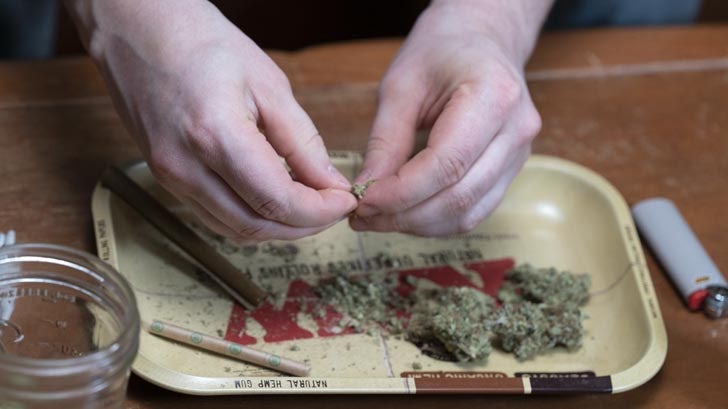All the hard work and tender love and care has paid off. You’re sitting in front of your first-ever cannabis harvest — and several ounces of top-shelf cannabis flower that you brought into the world.
But in the weeks up to harvest — and when you were trimming the buds — you also managed to collect a healthy amount of cannabis trim. How much trim and how useful it will be depends on the plant itself and the success of the grow. Many chemovars grow leaves that are covered with glistening, sticky trichomes, while others provide a less generous bounty. And plants grown by a more skilled cultivator typically turn out a more productive harvest.
But if you’re thinking of just tossing it in the compost pile, don’t be so quick. There is no shortage of uses for cannabis trim, and tons of easy ways to make that first successful grow even more bountiful.
Weed trim vs. weed shake
“Trim” refers to the leaves trimmed off the cannabis plant during the grow and the harvest. Some plants produce more abundant leaves and need to be trimmed more often, while many growers trim heavily as a way of boosting their yield. Trim doesn’t have the rich load of cannabinoids that you find in the cannabis flower, though that depends on what kind you’re talking about.
There are two main types of leaves on the cannabis plant: sugar leaves and fan leaves. Sugar leaves are small leaves that grow out of the cannabis flowers and get their name because they are more heavily coated with trichomes full of THC and are commonly used to make hash. The trim also contains terpenes, which are responsible for the aroma and flavor of cannabis strains, as well as some of their physical effects. Fan leaves are the larger leaves that grow off the branches of the plant and have a less generous dusting of trichomes — though they can still be put to use.

Trim is not to be confused with shake however. Shake is what you have in the bottom of a baggie or a jar where you keep your cannabis flower. It can range from little pieces of dried flower that broke off the bud during handling to trichomes that fell off and collected at the bottom, or usually a mix of the two. It is much more potent than cannabis trim, though it can be used in many of the same ways that you can put trim to use.
Just how potent? Determining the THC content of your sugar leaves (and the less potent fan leaves) will depend on a number of factors including the cannabis strain used, how much THC it has in it, and how much resin it produces. One writer estimates that it can range from about 2-3% THC, to around half of the THC percentage of the cannabis flower of the strain it came from. In which case, when using a recipe that calls for cannabis flower, doubling the amount of sugar leaves would be a logical conclusion.
So what to do now that you have all those trimmings? Here are five great ideas for what to do with weed trim.
5 things to do with weed trimmings
Make cannabutter with weed trimmings
Edibles need a THC infused fat — and cannabutter works like a charm. While most people think you need to grind up at least several grams of flower to make cannabutter, you can actually get by with just trim.
Basically, you make it just like you would normal cannabutter. First grind and decarboxylate the trim, and then add it to a cup of butter that you have melted in a pan with a cup of water. Let it simmer at low heat for 2-3 hours, and then strain it through a cheesecloth.
While sugar leaves have more trichomes, your trim still won’t be as potent as cannabis flower, so you might want to try to use a larger amount than you would in the regular recipe, around twice as much if not more. If you’re using fan leaves you will need a far larger amount than if you were using cannabis flower, and it will most likely be heavy in CBD.
Make a tincture with weed trimmings
Tinctures are a smoke-free, discreet, and effective way to use cannabis — and not only for medical patients.
Depending on your strain, the trim should have enough trichomes and terpenes to make an effective extract. Just follow the same steps you would if you were using ground up flower. Because there’s less THC in sugar leaf trim than in flower, a general rule of thumb is to use twice the amount of sugar trim than flower. And while this is not an exact science, if you were to use 4 grams of decarboxylated, ground up flower to make a small batch tincture, use around 8 grams of sugar leaf trim. Then just put it in a jar with 4 ounces of Everclear, shake it up, and let it sit for at least 24 hours.
Tinctures can sit for weeks or even a month or longer, and typically the longer you let it sit the stronger it will be.
Make cannabis milk with weed trimmings
Using cannabis infused milk to eat your breakfast cereal is not a traditional “wake and bake,” but one you may want to try if you have a pile of trim on the kitchen table.
The best part is it’s quite easy. First, heat a half pint of milk in a saucepan to where it’s hot but not boiling. Dump in a couple grams of ground, decarboxylated trim, and let it simmer at medium heat, stirring occasionally, for an hour and a half. Afterwards, strain the milk into a container and you’re done.
Your morning just got a lot more interesting.
Make a homemade skin cream with weed trimmings
Cannabis topicals are a popular intake method because of their potential to treat aches and pains and a variety of skin conditions, because they can by activating cannabinoid receptors on the epidermis. And while evidence for their effectiveness — especially when compared to transdermal products — is lacking, they can still be effective, and you can make your own with weed trim.
To make your own weed trim salve, you need a carrier oil, such as coconut oil or olive oil. Take around 10 grams of decarboxylated trim (the cannabinoid profile of the strain will determine the potency), and simmer it in around a cup and a half of coconut oil in a pot on a low simmer for about a half hour.
Take the pan off heat, and pour through a cheesecloth into a jar.
Some people add beeswax (around ⅓ or ½ cup) when making a salve, in order to lock in the moisture when applied to the skin. Melt the beeswax in a double boiler and combine with the coconut mixture. You can also add essential oils if you like, such as menthol or tea tree oil, or terpenes that are also found in cannabis.
Make hash with weed trimmings
Hash has been a mainstay of the cannabis world for ages — largely because it’s easy to make. Hash is prepared by taking the trichomes — the kief — from the cannabis plant pressing them to create a cannabis concentrate that can be crumbled up and smoked or used to prepare all types of edibles.
Your main issue is finding a way to remove the kief from the trimmings and then to press them into hash.
First, make sure your trimmings are completely dry and then put them in the freezer for at least 24 hours, which will make the trichomes easier to remove.
Take a sifting screen and pour the trim on top and sift it into a bowl or pan. Repeat multiple times — refreezing before each run — until you have removed the trichomes. Add a couple drops of water to the kief, place it on a large piece of foil or saran wrap and press it with your hands or a heavy object until you form a chunk of hash.
Let it sit for about 24 hours for the water to evaporate.
Another method is to use wax paper instead of saran wrap or foil, and to scrape together the kief and use a pollen press to press it into hash.
To make a purer, more potent kief, try using a “bubble bag” which is a specially made extraction bag with a 220 micron filter that is perfect for filtering kief. Basically, the smaller the micron filter, the purer — and more potent — the hash.
Make rosin with weed trimmings
Rosin is one of the more popular cannabis concentrates, and you can make your own batch easily with weed trim.
You don’t need to have your own industrial rosin press either, a simple hair straightener will do.
Take some ground up trim and put it inside a rosin bag or a mesh bag. Put the bag between two pieces of parchment paper and heat your hair straightener on low and place the paper holding the trim inside. Press for between 5-30 seconds, and check how much oil came out. You may need to repeat this step a couple of times.
Remove the parchment paper and discard the trim. Scrape up the rosin, and you’re good to go.
Sign up for bi-weekly updates, packed full of cannabis education, recipes, and tips. Your inbox will love it.

 Shop
Shop Support
Support


















